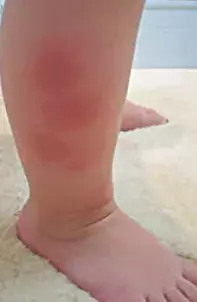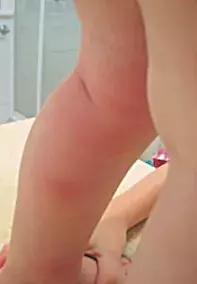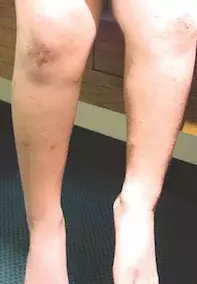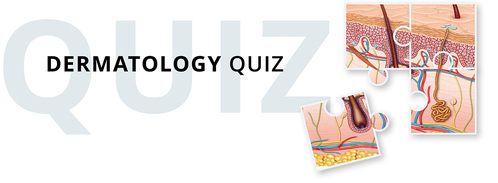What’s the diagnosis?
A girl with itchy plaques on the arms and legs



Case presentation
A 3-year-old girl presents with crops of pruritic erythematous raised plaques and excoriated vesicles on her forearms and lower limbs (Figures 1a and b). There are associated excoriations and crusting around the plaques on a background of erythema. The girl’s mother describes a similar presentation the previous summer following a mosquito bite.
The mother says that they have recently returned from a beach holiday on the north coast of New South Wales. Although other members of the family were bitten by mosquitoes on this trip, no one else had a similar rash. She wants to know if there could be another explanation for the skin eruption.
Differential diagnoses
Conditions to consider among the differential diagnoses include the following.
- Prurigo nodularis. Regular rubbing and pressure on the skin produces this common localised skin thickening (Figure 2). Patients describe an intense need to scratch the skin, which may have been precipitated by an insect bite, an underlying skin condition such as eczema or trauma. In other cases, persistent scratching may be a manifestation of anxiety or obsessive compulsive behaviour. Not all individuals are susceptible to prurigo. In people who are susceptible, however, constantly scratching and irritating the skin can produce thickened papules and nodules with hyperpigmentation and occasionally secondary infection. The nodules are characteristically distributed in easily accessible sites, such as the forearms, lower limbs and chest. This is not the diagnosis for the case patient.
- Lymphomatoid papulosis. This rare condition is a chronic recurrent, benign papulonodular eruption with histological features of cutaneous lymphoma. It presents with recurrent papulonectrotic and/or nodular lesions affecting mainly the trunk. The lesions progress rapidly over days and develop ulcerated necrotic centres. Although there is a risk of progression to a more aggressive lymphoma (which occurs in less than 5% of cases), the prognosis of patients with lymphomatoid papulosis is generally very good.1 Lymphomatoid papulosis typically first presents in adults and would be very unusual in a 3-year-old girl.
- Papular urticaria. This is the correct diagnosis. Papular urticaria is a common hypersensitivity disorder in which insect bites, commonly from mosquitoes, fleas or bedbugs, result in recurrent and pruritic papules. It is seen almost exclusively in young children but can occur in adults on first contact with a particular insect. Papular urticaria is mediated by a complex immune response with both IgE response and a cell-mediated type IV response.2 Immunological memory results in a confusing picture, as even one new bite will reactivate previous ones, resulting sometimes in a persistent and widespread rash. The intensity of the reaction is often related to the host response to salivary or contactant proteins.3
Management
Treatment for papular urticaria in the paediatric setting includes nonsedating systemic antihistamines for relief of itch and a potent topical corticosteroid such as betamethasone dipropionate 0.05% ointment, with application frequency titrated to the severity of the lesions. The lesions are characteristically very itchy, and dressings are an important adjunct to treatment to prevent scratching. Bacterial superinfection should be treated with appropriate antibiotics.
Advice on avoiding insect bites is essential, and it is important to seek historical clues to identify the culprit insect. Lesions on exposed areas of skin such as forearms and lower legs are more likely to be the result of mosquito bites, whereas flea bites can be present all over the body and may be linear. Strategies to protect against mosquito bites include the use of insect repellent, mosquito nets and clothing that provides good coverage when outdoors and the avoidance of stagnant water and insect-prone areas. In spring and summer, children should be carefully protected in the evening when mosquitoes are most active. Parents sometimes express a reluctance to apply the chemical compounds in insect repellents to their children’s skin, in which case the repellent can be applied to hair and clothes. If the skin eruption results from flea bites, pets should be treated and pest control agents (such as a ‘flea-bomb’) used in the house.
It is important to provide reassurance to parents that children eventually outgrow the disease. Children usually desensitise within two years and the eruption resolves. The prognosis for patients with papular urticaria is good.
References
1. Agar NS, Wedgeworth E, Crichton S, et al. Survival outcomes and prognostic factors in mycosis fungoides/Sézary syndrome: validation of the revised International Society for Cutaneous Lymphomas/European Organisation for Research and Treatment of Cancer staging proposal. J Clin Oncol 2010; 28: 4730-4739.
2. Garcia E, Halpert E, Rodríguez A, Andrade R, Fiorentino S, García C. Immune and histopathologic examination of flea bite-induced papular urticaria. Ann Allergy Asthma Immunol 2004; 92: 446-452.
3. Demain JG. Papular urticaria and things that bite in the night. Curr Allergy Asthma Rep 2003; 3: 291-303.
Skin lesions

